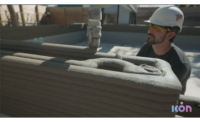Changing the materials used in the built environment is often a slow process. The construction industry can be skeptical of ambitious new products, preferring to select materials by price and reliability. But ask around today and one will find real advances in materials science as researchers reinvent construction’s building blocks through chemistry and ingenuity.
Advocates for new building materials are seeing a push for materials that far exceed requirements for sustainability. Material ConneXion is a global resource library for architects, designers and engineers. Its libraries have thousands of material samples on file and add more than 40 new items every month.
Andrew Dent, Material ConneXion’s vice president of library and material research, oversees the collection and has noticed a shift in the sustainability argument for new materials in recent years. “Sustainability has gone from being a marketing thing to a compliance thing,” he says. “Now, the manufacturers have caught on that they need to tell the sustainability story for their product, often just to comply with the regulations in place. Sustainability is a lot more readily available and understood.” The marketing push for it is over, as people in the construction industry now “come and talk to us and expect it. Sustainability is more of a constant background thing now,” adds Dent.
With sustainable goals now more common in construction projects, Dent sees manufacturers pushing the limits of sustainable materials—and that sets them apart in a more crowded field. “Right now, we’re seeing a lot of engineered naturals,” says Dent. “What we are taking is harvested, grown, in some way from nature, then engineering them to change their properties.”
Dent notes many requests from designers looking to set their projects apart through building materials that are made from either naturally grown materials or recycled waste. One example is a product called “biobricks,” manufactured by Italy-based Biomattone. They are made of a mixture of the woody part of the hemp plant and a natural lime binder. Another standout, according to Dent, is MyCo Board, a structural sheet material made by Green Island, N.Y.-based Ecovative. Grown from mycelium fungus and agricultural waste, the boards have properties comparable to medium-density fiberboard.

“Right now, we’re seeing a lot of engineered naturals.”
–Andrew Dent, Material ConneXion
Recyclables are also a growth area, according to Dent. He cites Eco-Board, a wood-like panel manufactured by Thailand-based Fiber Pattana Co. Ltd., which makes it from recycled beverage cartons.
New applications for wood may come from laboratory experiments that are starting to bear fruit. Researchers at Sweden’s KTH Royal Institute of Technology have developed a process for manufacturing transparent wood on a large scale. They were able to remove the lignin from the wood cellulose through a simple chemical treatment, turning it white. Then, they impregnate the substrate with a transparent polymer, rendering the wood optically transparent without compromising its structural strength. Noting that the wood could be produced in a large enough volume for non-architectural purposes, Lars Berglund, KTH researcher, says transparent wood could be used not only for windows but also in the manufacture of photovoltaic solar panels.
Transparent wood is just one new potential application for wood today. Materials manufacturers “are getting to the cellulose structure of wood and then changing its structure so it has different properties,” notes Dent. “It can be used as foam or to improve strength of other materials. We’re seeing a lot of companies in the forestry industry pushing some of these new wood products.”
New Uses for Proven Metals
While the hyper-green renewable materials are on the rise, cost can be an issue, according to Dent. But he also is seeing new approaches in more established areas of construction materials. “Five years ago, if people asked me about metals, I would have thought we came to the end of improving metal. But now they find new ways to improve it,” he notes. “Digital design tools are giving designers new ways to think about metal shapes.”
Beyond custom architectural metals, there is also new thinking in structural metals. “For us, right now, the real exciting stuff is in the mixing of materials,” says Charlie Carter, AISC vice president and chief structural engineer. “Steel has always done that, of course. A big innovation in mixing materials that I see coming is the wood industry pushing cross-laminated timber.” On their own, these CLT panels are not bad, says Carter, “but put those wood panels into a steel frame, put on a concrete topping, and it’s very competitive with a typical flat-plate concrete standard floor.” Carter acknowledges that much more testing is required for new structural-steel systems, but, so far, results are promising. “I could see the residential marketplace shift from flat-plate concrete to these CLT panels on steel frames in the future,” he says.
Getting the Cement Out of Concrete
Cement production’s carbon footprint is well documented, and many research initiatives and specialty products are seeking to reduce the greenhouse-gas emissions of the cement industry. The problem isn’t inspiration but, rather, getting new, largely unproven mixes into compliance with codes.
Despite these hurdles, industry associations are working to accommodate new advances in materials science. “For us, probably one of the biggest changes in cement is the recent development and future use of portland limestone cements,” says Paul Tennis, director of standards and technology for the Portland Cement Association. “This material had a long history in Europe, and Canada adopted it before the U.S. Here, nobody wants to be the first to use it, but they’ll come to it once they start seeing it as a more common material.” Limestone portland cement (LPC), classified as Type 1L cement in the PCA standard, can contain up to 15% limestone. “Production of 1L releases 10% less CO. That may seem small, but multiply it by the large volume of cement out there and you’ll see the impact,” says Tennis.
Type 1L does have its limitations, but Tennis says the lower CO emissions are worth having to rewrite and refine standards. “Cost is an engineering fact of life. But in the grand scheme of the environmental movement, there is also the cost and societal impact. Engineers are trying to balance those three things at all times,” he says. “A large part of the interest in limestone and other novel materials is the environmental part of that equation. The cost is the same or slightly higher, but the environmental benefit tips the scales.”
Getting new specifications for concrete admixtures takes time, but that environmental factor is driving much of the interest in novel materials. Researchers at the University of British Columbia’s Okanagan campus have been experimenting with recycling waste glass from landfills into concrete to reduce the cement content. Using a proprietary styrene butadiene rubber binder, researchers were able to replace a significant percentage of the portland cement in concrete with pulverized glass. “So, with the glass powder, we have silica, and in the cement we have alkali,” explains Shahria Alam, associate professor at UBC. “They react, forming a compound that expands and can cause cracking in the concrete. But we were able to optimize the material combination using this liquid-based polymer and retain strength.” Alam says the stabilizing polymer has been shown to prevent the alkali reaction in concrete with up to 25% glass content. The glass-infused concrete is still relatively early in development, but test results to date are promising, according to Alam’s co-researcher, Anant Parghi. “We have to do a detailed investigation, but, so far, we are 60% over the control sample for strength.” Despite this, Alam says getting it into standards will take time.
Learning To Mimic the Natural World
Working in his lab at Arizona State University, Prof. Ed Kavazanjian is looking for geoengineering solutions in nature. As the director of the Center for Bio-mediated and Bio-inspired Geotechnics, he currently is overseeing a recently awarded, five-year, $18.5-million grant from the National Science Foundation to investigate how natural processes can be adapted to benefit construction. “Turning sand into sandstone—that’s the kind of alchemy we work on here,” he says. CBBG is casting a wide net, looking at everything, from how geotechnical systems could mimic tree roots to considering how foundation pile-driving might learn from burrowing moles.
“Our general philosophy is that, in 3.4 billion years of trial and error, nature has come up with some very efficient ways to deal with the Earth’s materials,” says Kavazanjian. “We want to learn how nature does this and reproduce it for engineering purposes.”

“Turning sand into sandstone— that’s the kind of alchemy we work on here.”
–Ed Kavazanjian, Arizona State University
While the CBBG is pursuing many different areas of research, Kavazanjian’s focus is building foundations. Recent lab work on carbonate sedimentation has yielded promising results, with loose sand converted to rock-like hardness using urease, the same enzyme responsible for the formation of kidney stones. The process developed by the lab at ASU uses a plant-derived enzyme to induce the reaction. A CBBG partner project at the University of California, Davis, uses microbes. This chemical reaction could be used to firm up unstable soils, which, in the future, could strengthen building foundations and reduce the effects of soil liquefaction during seismic events.
Of CBBG’s current initiatives, the “sand-to-sandstone” process will be the first to see commercial use, says Kavazanjian. “With carbonate sedimentation, we could produce biobricks out of sand,” he says. “In geotechnical reinforcement work today, we do deep-soil mixing with portland cement, but, in the future, we could just sink perforated pipes and reinforce the soils through biochemical reactions.”
“I said it earlier, but I really call what we’re doing here geotechnical alchemy,” says Kavazanjian. “Instead of turning lead into gold, I want to turn sand into sandstone. If I can cement sand ahead of time and just tunnel through it, there’s a lot of possible applications for that in engineering.”











